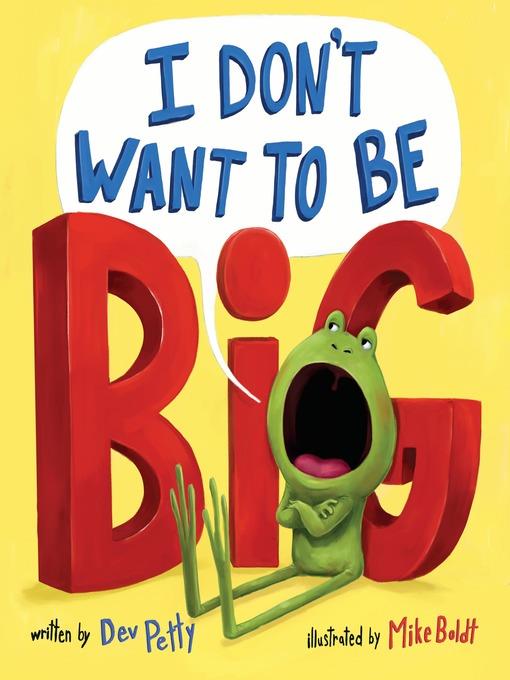
I Don't Want to Be Big
فرمت کتاب
ebook
تاریخ انتشار
2016
Lexile Score
510
Reading Level
0-2
ATOS
1.6
Interest Level
K-3(LG)
نویسنده
Mike Boldtشابک
9781101939222
کتاب های مرتبط
- اطلاعات
- نقد و بررسی
- دیدگاه کاربران
نقد و بررسی

Starred review from November 24, 2014
First-time author Petty’s dialogue between a frog father and his son makes its point about accepting one’s nature with a big grin. Boldt (Colors Versus Shapes) draws the two with exaggerated stringiness: the son is all rubber lips and sticky toes, his bespectacled father working as straight man. The young frog would rather be a cat, or perhaps a rabbit. “You can’t be a Rabbit,” says his beleaguered father. “Why not? Look, I can hop!” “Sure, but where are your long ears?” The small frog looks up, purses his lips, and feels around his head—nothing! “Besides,” his father adds, “what’s wrong with being a Frog?” “It’s too slimy,” the young frog replies. He wants to be a pig, then an owl, until a wolf appears—one who loves to eat cats, rabbits, pigs, and owls, but considers frogs “too wet and slimy and full of Bugs.” Now the frog sees his existence in a delightful new light. The story might create similar gratitude in the minds of readers—or it might just make them giggle. Ages 3–7. Illustrator’s agent: Jennifer Rofé, Andrea Brown Literary Agency.

July 15, 2016
A small frog boldly proclaims its reluctance to become big; an adult frog and a pig help it reconsider its views.As in Petty and Boldt's earlier collaboration, I Don't Want to Be a Frog (2015), the expressions on the frogs' faces are perfect: belligerence from the little frog and weary cynicism from the adult, who is probably the younger frog's parent. The art also lends excellent credibility to the little frog's concerns about being unable to fit in the book and terrible at hide-and-seek; only partial views are given of the comical elephant referenced by the child-frog. The text in which the frogs discuss the pros and cons of being big--shown in dialogue bubbles--seems a bit flat, however, probably because most young children want to be bigger. Young children also generally want independence, so the little frog's assertion that "I have big friends" to reach some cupcakes when it can't again seems lame. There is plenty of humor, much of it stemming from the art, as when the little frog decides it might not want to meet the tree frogs and the double-page spread suddenly fills, startlingly, with a close-up view of red-eyed tree frogs staring out at readers. The endpapers are also funny, showing an elephant's trunk using a pencil to mark the little frog's growing height. The little frog's final proclamation may lead to a sequel with a complaint more expected from young ones. The premise is weak, but the silly pictures make this an enjoyable read-aloud nevertheless. (Picture book. 3-6)
COPYRIGHT(2016) Kirkus Reviews, ALL RIGHTS RESERVED.

October 1, 2016
PreS-Gr 1-A little frog has a spirited discussion about why he doesn't want to be big in this amusing picture book. Two bright green frogs, one little and one big, talk about why eating dinner is so important. The little frog goes on to explain that he does not need to eat dinner, since he has no interest in being big. After some hilarious questioning from the older frog, the little frog finally decides that getting big might not be so bad, as long as he does not ever have to take a bath. The lively illustrations, with few background details, are a great match for the use of speech bubbles in each spread and are reminiscent of Mo Willems's "Elephant and Piggie" series. Children should be able to easily identify which character is talking throughout. VERDICT An amusing book about why getting big doesn't necessarily mean you have to grow up. A general purchase for most libraries.-Brooke Newberry, La Crosse Public Library, WI
Copyright 2016 School Library Journal, LLC Used with permission.

























دیدگاه کاربران